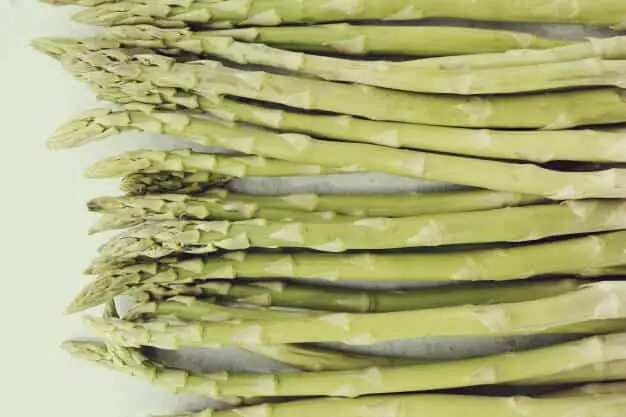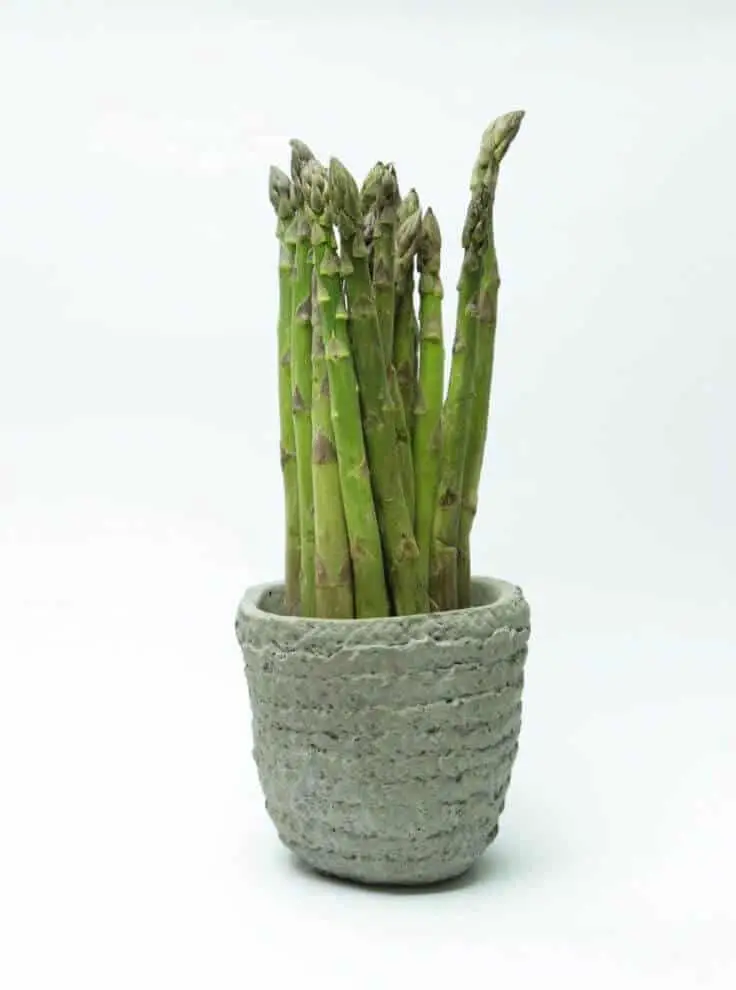Asparagus, aka garden asparagus with scientific name Asparagus officinalis, or folk name sparrow grass, is a hardy, flowering plant species classified under the genus Asparagus. A fun fact to note is that there are different speculations about its origin but it is generally agreed that it is native to the western temperate of Europe.

In this article, I’ll give a brief yet detailed introduction to the asparagus plant then I’ll explain how you should go about growing asparagus in a container.

As said earlier, the asparagus plant is a perennial herbaceous plant that can grow about 40 in. to 60 in. (100 cm to 150 cm) in height. It has sturdy stems and feathery branched foliage. Its leaves are in fact cladodes. Cladodes are modified stems that have a needle-like appearance and they fall in the axils of scale leaves. They can grow to varying lengths within the range of 6 mm to 32 mm and usually have a width of 1 mm. These cladodes grow in clusters and these clusters can have any 4 to 15 of them arranged in a shape similar to that of a rose.
Good to Read : How To Split Asparagus
Growing Asparagus in a Container
There are several reasons why you might choose to grow your asparagus in a container. Even though the optimal condition for growing asparagus is an outdoor garden because they thrive in habitually moist soils that have been deeply cultivated. In these conditions, after establishment, farmers and gardeners can be assured of harvests for more than two decades. A spacious garden is essential to the healthy growth of asparagus plants due to the plants’ characteristically large root system. However, not everyone has a garden or wide space. Fortunately, there are alternatives for people living in small or tight spaces.
One of the best alternatives for people without space for a garden to grow asparagus is growing them out of a container. When you are planting asparagus out of a pot there are several factors to take into consideration and they include:
Growth rate: Asparagus plants grow very slowly in comparison to other garden plants. This duration is especially long if you start growing them from their seeds as it can take about two to three years before its full development. The plant should not be harvested during this waiting period. Many gardeners choose to avoid this waiting period by purchasing asparagus plants as crowns. Crowns are plants that have already been cultivated for one or two years and have already grown a bit which decreases the duration of time you have to wait before the asparagus plant is established.
Planting space: Growing asparagus in a container might be one of the best alternatives for growing the plant within a tight space but it negatively affects the lifespan of the asparagus plant by shortening it greatly. When asparagus is grown in a garden, you can expect more than twenty years of harvest as opposed to the two or three years of harvest you get when the asparagus is grown in a planter, pot, or container.
After deciding whether to grow your plant indoors or outdoors you’ll have to choose whether to grow your plants from seed or purchase crowns to shorten the growth period before you can begin to reap your harvests. Purchase crowns from your local nursery and inquires into the age of the crowns. Buying older crowns means you’ll be able to harvest sooner.
Sunlight: First, you have to decide if you’ll be growing the plants indoors or outside. If you decide to grow them indoors you’ll have to consider how to provide enough sunlight for the plants as asparagus plants need a lot of sunlight to grow especially in the winter. Providing enough sunlight to meet this requirement might be difficult indoors.
Carefully select the right location to grow your asparagus plant. Take note of the spots that get the most sunlight as asparagus needs a minimum of eight hours of sunlight every day even during winter. Planting your asparagus in a container becomes advantageous in this aspect as you can easily move the container if you determine that the plant isn’t getting enough sunlight.
Planting period: The time at which you plant your seeds or crowns is also very important and the optimal time for planting your asparagus crown or seed (depending on which you purchase) is between March to April when the temperature is lower than 64℉.
Choosing the right container size: Select the right container size for growing your asparagus plant as this is very crucial. The success of your efforts is very dependent on this step. Asparagus plants are perennials meaning they need a lot of space for their root system. When growing asparagus in a container, you should only grow one plant per container to prevent root disease. Also, the pot should be at least 20 in. deep and 20 in. wide in diameter. The most popular options for plant containers are plastic and terra cotta but plastic is favored over terra cotta due to its durability and affordability.
Prepping the container: It is also necessary to make drainage holes at the bottom of the container. This is necessary to ensure there is no standing water in your pots as it kills plants very quickly. Put two inches of gravel in each plant container to decrease the chances of your plants having wet feet. This gravel prevents your asparagus plants from having wet roots and provides better drainage while simultaneously reducing the risk of your plants breeding harmful fungi.
Soil type: Provide the right soil for your asparagus by purchasing a potting soil mix from any nearby garden store. These mixes are made from compost, peat moss, perlite, and other ingredients mixed in the right quantity to provide an optimal growing environment for your plant. The ideal soil pH for growing asparagus varies between 6.5 and 7.5.
You can use auxiliary means to increase or decrease the pH of your soil according to your preference. Use lime to increase the pH and sulfur to decrease the pH. It is critical for the growth and health of your asparagus plant that you water it constantly. The soil in your container plant should be moist but not soggy as it can lead to rot in the root of your plant. This is why your plant must have drainage holes.
Want to know more about gardening ?
Fill in your email address in the form below and you'll receive all the latest updates directly in your in-box.
Thank you for subscribing.
Something went wrong.